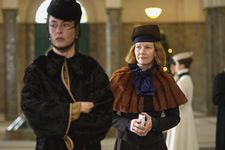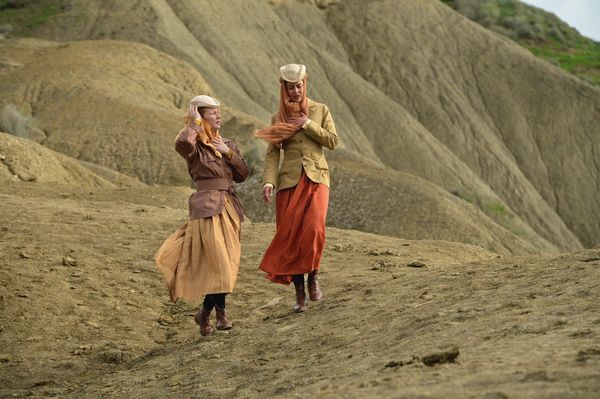 |
| Frauke Finsterwalder on Tanja Hausner’s Sisi & I wardrobe for Sandra Hüller and Susanne Wolff: “I think each one of them had around thirty different costumes, they were all handmade …” |
Frauke Finsterwalder’s razor-sharp Sisi & I (screenplay co-written with Christian Kracht, her collaborator on Finsterworld) opens with Portishead’s Wandering Star and begins to close with Sandra Hüller singing Marc Bolan’s Cosmic Dancer. The exquisitely stylish take on the Sisi legend (with Tanja Hausner’s eminently tempting and chronology defying costumes) stars the defiant duo of Susanne Wolff as Empress Elisabeth of Austria-Hungary, with Hüller as Irma Countess of Sztáray, her lady-in-waiting. The extraordinary supporting cast includes the two protagonists’ mothers, Sibylle Canonica as Marie Countess of Sztáray and Angela Winkler as Ludovika of Bavaria, plus Georg Friedrich as Sisi’s playful cousin, Archduke Viktor of Austria.
 |
| Frauke Finsterwalder with Anne-Katrin Titze (wearing heirloom lizard brooch): “I like these elements of horror or these creepy feelings in my films, and fairy tales are a good way of portraying it.” |
With the help of production designer Katharina Wöppermann and cinematographer Thomas W Kiennast, Finsterwalder constructs a paradise for our eyes to wander and dream, and experience what life in the shadow of the most admired woman of her time holds in store.
From the UK, Frauke Finsterwalder joined me on Zoom for an in-depth conversation on Sisi & I.
Anne-Katrin Titze: Hi!
Frauke Finsterwalder: Hi, how are you?
AKT: I’m fine, how are you?
FF: Really well, thank you!
AKT: Let’s talk about Sisi & I! Licht an, Licht aus - Lights on, lights off is not only a perfect starting point, but seems to structure a lot in the film.
FF: Yes, definitely. Irma predicts in the beginning the suffering she will go through throughout the film. Quite a painful process, but also quite an addictive process that I think many of us can maybe relate to. I don’t know if you’ve ever been in friendships like that, but it happens from a very young age on that we’re exposed to these experiences. Irma, who is a middle-aged woman, but hasn’t grown up much, she also approaches it in a very childish way.
AKT: The childishness reminded me of Freud’s fort-da game, which asks: Whom can I control? How can I control?
FF: Definitely. This is something very human, I guess, and children start very early on to test it. It can be just shutting the door on your parents when you’re a toddler, but it can go on throughout life and, of course, in this case it is with someone who is quite powerful and so Irma has not many ways to defend herself. Or she falls for it quite easily, because her boss is the pop star of her time. They become friends, or not, it’s not very clear what Sisi’s intentions are, but she quite enjoys Irma’s company at times and then she plays with her quite a bit.
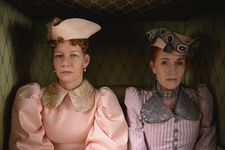 |
| Sandra Hüller as Irma Countess Sztáray arriving with Sybille Canonica as her mother (Marie Countess Sztáray) |
AKT: One of my favourite scenes is with the two of them and their mothers. Partly because the choice of actresses is so great. I remember seeing Sibylle Canonica on stage at the Kammerspiele under Dieter Dorn. It is all about manipulation and food and Angela Winkler has a history [with memorable eating on camera] from Volker Schlöndorff’s The Tin Drum. Can you tell me a bit about that scene?
FF: Yes, of course. I was trying to create a little bit of a background to the two lead characters. In Irma’s case, we meet her mother in the first scene, actually. And we learn that the mom is not very kind and that there are many reasons why Irma would want to get away and out of that abusive relationship. And, you know, the whole film there is a layer of violence all over the place, sometimes verbally, sometimes physically. Starting with the mother abusing Irma in the first scene, which is kind of a shock because Irma is not a little kid, she’s a grown woman.
Sisi, we don’t learn a lot about her background, so I really wanted to show her mother in the film to show that she, who is quite abusive throughout the film, has suffered from abuse probably from an early age on. So it’s generations of passing on these things. Of course the food, because the film is also a lot about eating disorders and slimming and this obsession with your physical stature and aging. We all know that a lot of that comes from the mother because she is the first one who is feeding the child. So to refuse the food or to spit it out, that’s something like a rebellion against the person who is feeding you.
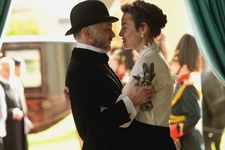 |
| Emperor Franz-Josef (Markus Schleinzer) with his wife Sisi (Susanne Wolff) |
And the casting of Angela Winkler - I had a very strong actress as Sisi, Susanne Wolff, who is also larger in life as a person, as an actress, so I had to find someone who could be the mother. And Angela, who is actually very sweet, is very good at portraying this villain character. With Sibylle it was interesting, because Sibylle really had a big issue with being the mean mother. Right at the beginning when she hits Irma - and I’m not going to spoil how she hits her, because it’s not just a slap in the face - it’s quite brutal, and she had a huge problem with that. Because she didn’t want to hit her daughter and there were all these questions and we had a lot of conversations about it. Even in the supper scene with the two mothers, Sibylle was always trying to kind of be nice to Irma in-between. But we edited that all out in the end. It’s interesting how she was really struggling with being that.
AKT: She has such an expressive face and I think we can see some of that struggle before it turns into meanness and get to decode it. And Angela Winkler is one of the best eaters on the screen. Nobody eats like her!
FF: I know, it’s incredible. I mean, it’s a funny story, you mentioned it, The Tin Drum, of course I think of that film when I think of her, but I actually had forgotten. This scene, and this is actually something a journalist pointed out to me later, is a repetition of the very famous scene with the eels, where her husband feeds her these disgusting eels and she is getting really sick. It’s a fun story, but it wasn’t really my intention, it just turned out to be like that.
 |
| Sisi (Susanne Wolff) lounging with her cousin, Archduke Viktor of Austria (Georg Friedrich) as Count Berzeviczy (Stefan Kurt) serves and spies on them for the Emperor |
And yes, she’s a fantastic eater and I think everyone was quite astonished. I also quite like the fact that she is a princess but she eats kind of like a peasant. She slurps and it’s kind of disgusting actually and I quite like that about the film. Because I always get very annoyed when I see historical films and aristocrats always eat with their pinky sticking out and they always sit up straight. So we had this rule throughout the film: Never sit straight, slurp if you want, you know, just be a human being! Don’t act to be something, because I think in reality this is what it was really like, not how we today think that people like that behaved.
AKT: We see from the start when Irma gets dressed up, that she has these dirty fingernails. Hinting that there is another life we don’t see! Bird sounds are big in your film. At one point, near the cliffs, Sisi says she wants to return to being a seagull she once was. Besides lizards and tortoises, birds make an appearance at least in the soundtrack.
FF: I guess there are two layers to it. First of all, I wanted to create a layer of sound because we don’t have much music in the film. We have music in terms that we have songs, but there is no soundtrack throughout. It was the idea to create a layer of sound through the birds, which in a lot of ways is not very realistic.
We have tropical birds in the garden in Greece and we have birds inside the house. You can hear them when Irma enters Sisi’s house in Corfu for the first time. And of course birds are a symbol of longing for freedom, flying away, things like that. Which is the story of Sisi, that she is trying to get out and be free and she is quite free when Irma meets her but then the reality grabs and tries to pull her back to where she has to be due to her position.
AKT: You say realism is not really the point. The same goes for the costumes, which are fantastic! Tanja Hausner in general makes remarkable costumes. I recently spoke with the directors of The Devil’s Bath [Veronika Franz and Severin Fiala] and there are of course the films she made with her sister [Jessica Hausner]. But in your film there seems to be even more playfulness! The clothes are stunningly beautiful!
FF: It’s interesting, you know, when I started to do some research on the whole subject and the era, I was very interested in the fashion, obviously, because me personally when I watch a period film, that’s what I want to see on the screen. I want to see the costumes because it’s so much fun.
AKT: I agree.
FF: And I looked at the costumes of the time, which are Victorian dresses, which have these huge shapes, you know, huge hips and you can’t move in them. In my opinion they are very ugly and I didn’t want these kind of costumes in my film because I wanted to tell the story of two quite modern women. So when I met Tanja for the first time, she’s Austrian, so she’s very familiar with the Sisi subject, she was a little bit weary because as an Austrian she wasn’t really keen on creating these kind of costumes from the 19th century that are very kitsch.
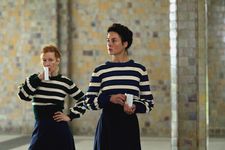 |
| Frauke Finsterwalder on Irma (Sandra Hüller) and Sisi’s (Susanne Wolff) look: “We decided to give them stripes, as prisoners who have escaped. ” |
You can’t really take people seriously that wear these kind of things, I feel. So we met and I had these two old books of Valentino fashion from the Sixties and I gave them to her, put them on the table. And she was like, okay, that’s interesting! She met me because of my previous films and she knew that it wasn’t going to be like a biopic with accurate costumes. Then she really got excited and we started to look at, you know, especially Italian fashion from the Sixties and Seventies because that’s when I feel a new type of very elegant, very confident modern woman was invented by Italian designers at the time.
But then also we looked actually in every century and we just stole whatever we liked. It was a lot of fun. Also them wearing trousers at times when they ride, because I didn’t want these romantic riding images that we’ve seen so many times in historical films, with the dress floating over the horse. I wanted it to be quite practical and cool.
AKT: You achieved that perfectly! The two striped outfits after they get off the train stand out. Is there anything special to those?
FF: That whole scene is kind of based on - what’s the term in film history? Escapee films maybe?
AKT: Oh, as from a chain gang?
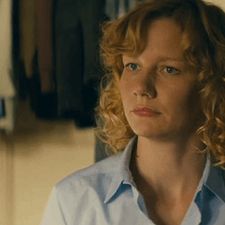 |
| Sandra Hüller as Franziska in Finsterworld |
FF: Yeah, because they are escaping, they are jumping off the train and it was a pretty rough landing. Yeah, so we decided to give them stripes, as prisoners who have escaped.
AKT: That is very funny! I had the feeling there was something special about these stripes but never would I have thought of escape movies.
FF: Those are very sought after! There was a Japanese designer that was trying to commission them. Actually she wanted to make a whole line of clothes about this film because there were so many pieces that you could actually wear nowadays.
AKT: I would, totally!
FF: So those are very loved by many.
AKT: Is there going to be a fashion line?
FF: No, it’s not going to happen. It would be so incredibly expensive to do that. But I can say that the actresses took a lot of the clothes for themselves after the shoot because they liked a lot of the pieces. We had a lot of costumes too. I think each one of them had around thirty different costumes, they were all handmade and we had these huge meetings in Vienna with these tailors making all the pieces. It was really a lot of fun.
AKT: You have an Aschenbach moment in your film!
FF: Finally! You are the first one who discovered it!
AKT: Aschenbach and Nico! It was very interesting how you show her aging in the Visconti way. Death is coming, it’s foreshadowing. Your scene is a little less terrifying than in the Visconti film [Death In Venice].
FF: Which is due to the fact that Victor, the cousin, he is really so gentle with her. Which is remarkable because I never thought that the actor, Georg Friedrich, could pull off something like that. Because normally he plays kind of shady, brutal characters and I think that he played that beautifully. And yeah, of course the scene is completely kind of taken from that film, also because I’m a huge Visconti fan. There are quite a few references within the film that are more technical, like using zooms a lot and things like that.
Everything you said, it’s the scene that gets us ready for what’s going to happen after and we, for the first time, see Sisi actually at the age that she is, and not the young person that we see before. And also it’s taken a bit from Japanese theater, before entering the last drama, the stage, you know, that is in there as the makeup is being put on.
AKT: The death mask face is so much the opposite of the giggling, moving faces that we saw earlier. Sandra Hüller and Susanne Wolff are quite wonderful giggling together, in the bathtub and elsewhere. They are so natural and infectious. I don’t remember seeing giggling fits like that. The two are very different as actresses. I interviewed both of them for different films, about Styx and Toni Erdmann, respectively. Tell me about how you came to casting the two of them together!
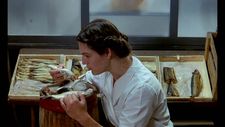 |
| Frauke Finsterwalder on Angela Winkler (here in Volker Schlöndorff’s The Tin Drum): “Yes, she’s a fantastic eater and I think everyone was quite astonished” |
FF: Yeah, that was my biggest question! You know, the film was written for Sandra. Because my previous film [Finsterworld], she was in it and we had said for years that we would make a big film together. Her role was written for her and it was a bit of a problem then to find a person who could be the Empress next to her, because Sandra is such an incredible actress and I’m telling a love story in the film. Irma falls in love with the Empress.
So I had to find an actress that Sandra would be interested in acting with, also in terms of technique. And someone who is actually quite impressive as a person. So we invited Susanne for a casting with Sandra. She entered the room and Sandra’s face just dropped, her chin just dropped and she was like, wow! Then I knew the whole thing would work with the Empress being this impressive person making an impression.
What we did with the casting then was the scene in the film where they take drugs together. They take hash together and they have this huge laughing attack. So we did that scene in the casting studio, which is really odd, you know, people wearing their normal clothes. It was on a carpet in some modern room in Berlin and they laughed so hard together. They just had so much fun, and that was actually the most important thing, if they would both be able to fall into this kind of childish way. Like teenagers or something, this hysterical laughter together. And it worked out and that’s how Susanne was cast as Sisi.
 |
| Dirk Bogarde in Luchino Visconti’s Death in Venice |
AKT: You wouldn’t expect that the two of them together work so well.
FF: It’s also important because a lot of portraits of Sisi always show her as this very struggling, very dark, very depressed person. But, you know, she was kind of borderline, I would say. She had both sides, she was, I would say, manic depressive. And I wanted to show the manic side as well. And also explain why it’s so much fun to be with her, not just because she is powerful and she is an Empress and all that. But also because she is really fun to be with. So it was very important that these scenes would work out for the concept of the film.
AKT: And there is the lights-on, lights-off concept again! I think Irma at the very beginning speaks of a sharp piece of glass stabbing the heart. It is already the first time that fairy tales came to mind. It made me think of Hans Christian Andersen’s The Snow Queen, in which the devil’s mirror breaks and then the shards of that mirror can fall into your eyes. It terrified me as a child. Later in your film, the Sleeping Beauty story comes in and Irma is corrected by Sisi, that, no it is not the fairy-tale heroine’s story, but that of herself, the Princess from “Bayernland.” Fairy tales had also played a role in Finsterworld.
 |
| Sisi (Susanne Wolff) and Irma (Sandra Hüller) on one of their hikes: “I wanted it to be quite practical and cool” |
FF: Yeah, I’ve always been fascinated by that. Of course, I grew up in Germany and it’s such a part of growing up in Germany that you are confronted with these stories. A lot of these stories have haunted us - you say the same about you - as children. The interesting thing is that these stories were not written for children originally, they were written for adults.
AKT: Right!
FF: They were what we today enjoy when we watch horror films. It was kind of like these really dark terrible stories that were told by the fireplace to just scare the shit out of people, basically. And it was never meant to be for kids. And that has always interested me a lot. In my generation and yours, and for a long time suddenly these stories were used to intimidate kids. Although they were actually too cruel for a child to bear. I’ve always been fascinated with it. I like these elements of horror or these creepy feelings in my films, and fairy tales are a good way of portraying it.
AKT: They add an extra layer of depth. There is always something more. Backwards and forward movements are also a big part of your film, up to the very end, when Sisi walks backwards and Irma talks about the future, in the future tense. The Annette von Droste-Hülshoff bonding moment I loved. Partly because I recognised the poem.
FF: The same with the soundtrack. I only wanted female voices in the film. You know, Droste-Hülshoff is one of the big writers from the 19th century and Sisi would have probably known of her, at least. Probably known the poem. So that’s how it came in, and it’s a feminist poem because it’s talking about how nice it would be if one could be free like a man, basically. I felt that that could be a good bonding between the two when Sisi actually discovers that Irma knows that poem. Because it’s not a poem that everyone at the time probably knew. So it’s something quite special that they share.
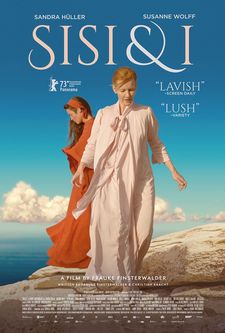 |
| Sisi & I poster |
AKT: It’s one of the lights-on moments for her. Also the poem speaks of hair, loosening the hair to let it flutter in the wind, something like that. And Sisi’s long hair is so much part of her myth.
FF: Yes!
AKT: The song Cosmic Dancer, sung by Sandra Hüller in the end, is a good way to send us off!
FF: The song, I feel that it kind of summarises the story that we’ve just been witnessing. Then Sandra is a very good singer, she’s done several albums, she loves singing. Since I only wanted female voices in my film, it’s a problem that T Rex is a man [Marc Bolan], who was singing Cosmic Dancer originally. Then we recorded it with Sandra, which was a lot of fun to do. It’s also nice that she gets to have the last voice of the film.
AKT: Did you see the documentary Angelheaded Hipster on Marc Bolan [Ethan Silverman’s Angelheaded Hipster: The Songs of Marc Bolan & T. Rex]?
FF: No!
AKT: Nick Cave is singing Cosmic Dancer in that one.
FF: Ah, okay, yeah, it’s been sung by many. It’s quite a remarkable song.
AKT: Thank you for this!
FF: Thank you! Take care!
Sisi & I opens in the US on Friday, July 12.








